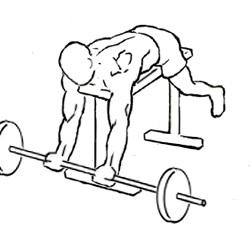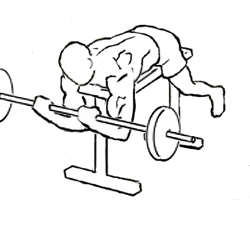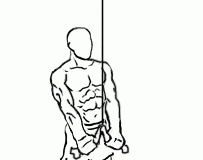Last Updated on September 26, 2014
When it comes to building powerful, well-defined biceps, the lying high bench biceps curl with a barbell is an exceptional exercise that deserves a place in your workout routine. Known for isolating the biceps and minimizing involvement from other muscle groups, this unique exercise allows for maximum engagement and growth of the upper arms. Here, we’ll dive into everything you need to know about the lying high bench biceps curl, including step-by-step instructions, benefits, variations, common mistakes to avoid, and advanced tips for getting the most out of this exercise.
Why the Lying High Bench Biceps Curl is Essential for Arm Development
- Enhanced Bicep Isolation
Unlike traditional standing curls, the lying high bench biceps curl removes momentum and limits engagement of other muscles, allowing for maximum bicep activation. This isolation makes it highly effective for anyone aiming to build or sculpt their upper arms. - Improved Muscle Definition and Symmetry
By isolating the biceps, this exercise helps address muscle imbalances, enhancing symmetry and definition. Focused, isolated exercises like the lying high bench biceps curl are ideal for creating a balanced, symmetrical look in the arms. - Reduced Lower Back Strain
Performing curls while lying face down on a high bench provides extra support and stability, reducing strain on the lower back. This makes it a safe and effective choice for individuals with back issues who want to strengthen their arms without risking discomfort or injury. - Excellent for Building Peak and Thickness
The lying high bench biceps curl works the full range of motion, targeting both the short and long heads of the biceps. Over time, this engagement builds thickness and a well-rounded peak, contributing to an impressive bicep shape. - Minimizes Cheat Reps
By lying down on a bench, it’s harder to use body momentum, which forces the biceps to do all the work. This strict form leads to better muscle engagement and growth.
How to Perform the Lying High Bench Biceps Curl with Barbell: Step-by-Step Guide
Follow these steps to perform the lying high bench biceps curl with proper form for optimal results:
1. Set Up the High Bench and Barbell
Position a high bench at a comfortable height where you can lie face down with your head and shoulders fully supported. Place a barbell on the floor at one end of the bench so it’s within reach.
2. Lie Face Down on the Bench
Lie on the bench with your chest and stomach resting on the surface and your head positioned at the end of the bench. Your feet should be planted firmly on the floor with your toes pressed against the ground to provide stability.
3. Grip the Barbell with a Close Grip
Reach down and grasp the barbell with your palms facing up, using a grip about 12 inches apart. This close grip is ideal for targeting the biceps, allowing for concentrated muscle engagement.
4. Begin the Curl Movement
With your arms fully extended towards the floor, exhale as you begin curling the barbell up in a controlled, arc-like motion. Focus on contracting your biceps as you lift, bringing your forearms as close as possible to your biceps without moving your upper arms.
5. Squeeze at the Top
When you reach the top of the movement, pause briefly to squeeze your biceps, maximizing the contraction. This peak contraction intensifies muscle activation and enhances results over time.
6. Lower the Bar Back to Starting Position
Inhale as you slowly lower the barbell back to the starting position, maintaining control to keep tension on the biceps. Avoid letting the weight drop, as this can reduce muscle engagement and increase the risk of injury.
Tips for an Effective Lying High Bench Biceps Curl
- Keep Movements Controlled
Focus on slow, controlled movements throughout the exercise. Avoid using momentum to lift the weight; instead, let your biceps do the work for each rep. - Use the Right Grip Width
Gripping the barbell with your hands about 12 inches apart is ideal for this exercise. This narrower grip helps target the biceps more effectively, while a wider grip could shift emphasis to other muscles. - Engage Core for Stability
Even though you’re lying down, keep your core engaged for added stability. A stable core will prevent any unnecessary rocking or movement, allowing you to concentrate on your form. - Don’t Rush the Movement
Take your time with each rep. The slower and more controlled the movement, the more effective it is for bicep activation. - Use Appropriate Weight
Start with a lighter weight if you’re new to this exercise to master the form. Increase the weight gradually to avoid sacrificing form or risking injury.
Common Mistakes to Avoid
- Using Excessive Weight
Starting with a heavy weight can compromise form, leading to shoulder or elbow strain. Begin with a manageable load that allows you to perform each rep correctly. - Curling Too Quickly
Quick reps reduce the effectiveness of the exercise. Instead, focus on slow, controlled movements to maximize muscle engagement. - Lifting with the Shoulders
Avoid lifting your shoulders or letting them creep up during the movement. Keep your shoulders relaxed, focusing solely on bicep engagement. - Lack of Control in the Lowering Phase
Letting the bar drop too quickly reduces the tension on the biceps and increases the risk of injury. Lower the bar slowly and with control for optimal results. - Gripping Too Wide or Narrow
A grip that’s too wide or narrow can affect the angle of the movement and reduce bicep isolation. Stick to a grip width of about 12 inches for balanced activation.
Variations of the Lying High Bench Biceps Curl
Adding variations to your routine can keep your muscles challenged and enhance bicep development:
- Lying High Bench Dumbbell Curl
Use dumbbells instead of a barbell to work each arm independently. This variation helps correct muscle imbalances and increases stability demands. - Incline Dumbbell Curl
Performing the curl on an incline bench with dumbbells shifts the angle, putting even more emphasis on the long head of the biceps, which enhances the peak. - Cable Lying Biceps Curl
Perform this exercise with a low pulley cable attachment for constant tension on the biceps throughout the entire movement, increasing the intensity and engagement. - Lying EZ-Bar Curl
Use an EZ (curl) bar instead of a straight barbell. The angled grip of the EZ bar can reduce wrist strain and may be more comfortable for some individuals. - Slow Tempo Curl
Slow down each phase of the movement, especially the lowering (eccentric) phase. This variation increases time under tension, stimulating muscle growth more effectively.
Incorporating the Lying High Bench Biceps Curl into Your Workout
Here are some strategies for including the lying high bench biceps curl into your arm workout:
- Strength Training Focus
For strength, perform 3-5 sets of 4-6 reps with a challenging weight. This low-rep range allows you to lift heavier and develop stronger, more powerful biceps. - Hypertrophy (Muscle Growth)
To build muscle size, perform 3-4 sets of 8-12 reps with moderate weight. This is ideal for achieving the muscle tension needed to increase bicep size. - Endurance and Tone
For muscle endurance, aim for 2-3 sets of 15-20 reps with a lighter weight. This higher rep range helps build endurance and improve definition in the biceps. - Use as a Finisher
Perform this exercise at the end of your biceps workout for a final burnout. Aim for 2-3 sets of 12-15 reps with moderate weight to fully exhaust the biceps. - Pair with Other Bicep Exercises
Combine the lying high bench biceps curl with exercises like hammer curls, concentration curls, or preacher curls to ensure balanced bicep development.
Safety Tips for Performing the Lying High Bench Biceps Curl
- Start with Light Weight
Begin with a light weight to master the form and prevent strain on the elbows and shoulders. Increase gradually as you become more comfortable with the movement. - Engage Core for Stability
Maintain core engagement throughout to prevent your body from moving on the bench. Stability in the core provides a safer and more effective lift. - Avoid Over-Gripping
Gripping the barbell too tightly can cause wrist strain. Hold the bar with a firm, yet relaxed grip to avoid unnecessary tension. - Focus on the Biceps
Keep your shoulders down and relaxed to avoid recruiting other muscles. Concentrate on contracting the biceps throughout the movement. - Progress Slowly
Avoid jumping to heavy weights too quickly. Steady progress helps reduce the risk of injury and encourages better form over time.
Frequently Asked Questions
Q1: Can beginners perform the lying high bench biceps curl?
A: Yes, but beginners should start with lighter weights and focus on perfecting their form. Consulting a trainer for guidance can help ensure correct technique.
Q2: How often should I include this exercise in my workout?
A: Include this exercise in your arm workout once or twice a week, with at least 48 hours of rest between sessions to allow for adequate muscle recovery and growth.
Q3: Can this exercise replace standard bicep curls?
A: The lying high bench biceps curl is an excellent addition to a bicep routine but shouldn’t fully replace traditional curls. Combining it with other exercises like standing barbell curls or hammer curls ensures comprehensive development of the biceps.
Q4: Is the lying high bench biceps curl suitable for people with shoulder issues?
A: This exercise can be safe for those with shoulder concerns since it minimizes shoulder movement. However, individuals with shoulder issues should start with lighter weights and consult a professional to ensure this exercise is safe for their specific condition.
Q5: Should I use a barbell or dumbbells?
A: Both options are effective. The barbell allows for a unified movement that targets both biceps evenly, while dumbbells enable independent arm movement, helping to correct muscle imbalances. Try both to see which option feels most comfortable.
Advanced Tips for Maximizing Results from the Lying High Bench Biceps Curl
- Slow Down the Eccentric Phase
Take 3–4 seconds to lower the barbell back to the starting position. This slow eccentric phase increases time under tension, stimulating muscle growth by putting extra strain on the biceps. - Incorporate Pause Reps
Adding a brief pause at the peak contraction—when the barbell is closest to your face—intensifies the engagement and further challenges the biceps. Try holding the top of each rep for 1–2 seconds before lowering. - Utilize Drop Sets
Perform a set to failure, reduce the weight by 20-30%, and continue curling to failure again. This high-intensity technique exhausts the biceps and encourages muscle growth by fully fatiguing the muscle fibers. - Mix Up the Rep Ranges
Alternate between heavy, low-rep sets and lighter, high-rep sets each week. Changing rep ranges regularly helps avoid plateaus and keeps the biceps constantly challenged. - Focus on the Mind-Muscle Connection
Concentrate on contracting the biceps with each lift. Visualizing the muscles working enhances the mind-muscle connection, helping to improve activation and lead to better results.
Wrapping Up: Build Strong, Defined Arms with the Lying High Bench Biceps Curl
The lying high bench biceps curl with a barbell is an outstanding exercise for anyone serious about building stronger, more defined biceps. By isolating the biceps and reducing momentum, this movement provides focused muscle engagement that leads to impressive gains in both strength and size. Whether you’re a beginner or an experienced lifter, this exercise can be adapted to suit your goals by varying weights, reps, and tempos.
Include the lying high bench biceps curl in your workout routine to achieve well-rounded, powerful arms that not only enhance aesthetics but also improve performance in a range of upper body exercises. With consistent effort, proper form, and gradual progression, this unique curl variation will help you reach new levels in your bicep development.








